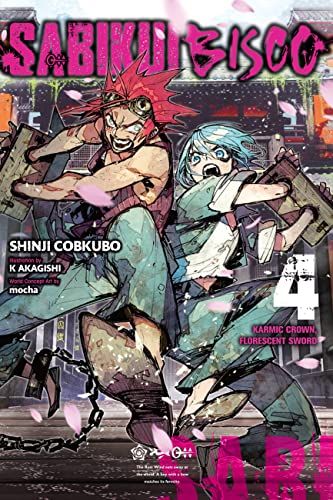By Shinji Cobkubo and K Akagishi. Released in Japan by Dengeki Bunko. Released in North America by Yen On. Translated by Jake Humphrey.
This review really cannot happen without spoiling the end of the book, so beware if you do not want to be spoiled, though I will try not to exactly spoil. Throughout most of this volume, this has the feel of a “makework” volume in the series, as events happen but it lacks the striking imagery of previous books, which was one of the major reasons we read it. It also is not as gay, which is the other reason we read it, mostly as Bisco and Milo spend most of the book separated from each other, and there’s only one or two moments, such as brief princess carry, or Milo staring in what is clearly jealousy at one point, that makes you realize the writer knows what they’re doing. But it’s all right. It’s got some really cool fight scenes, Bisco is funny at times, we have a new waif who needs to be guided/rescued, and we get a little more development of the post-apocalyptic works with a slave race. OK, that last part is questionable.
We open with a teenager escaping from what appears to be a maximum security prison, only to be caught almost immediately, and their rescue/medical treatment by Bisco and Milo, and we then backtrack to see why they’re in a prison in the first place. They arrive at what is supposed to be a mushroom keeper’s village only to find it nearly deserted, covered in sakura flowers. The tribe have been arrested and thrown into a maximum security prison by the warden, who is very big on justice in a “Shonen Cop Gone Bad” sort of way. Shishi is part of a tribe called the Benibishi, an artificially engineered plant-based species designed as slaves. All the Benibishi are ALSO in the prison, and Shishi’s father, their King, is due to be executed. Now Bisco and Milo have to get into the prison and try to resolve things… except that they’re promptly arrested and thrown in there anyway.
Starting off with the one really great part of the book. The third volume ended, to the surprise of most readers, with Pawoo marrying Bisco, and she’s come along in this book as well. Then, a third of the way through the book, the prison warden grabs her and simply throws her out of the book and back to her home town. We never see her again. It’s jaw-droppingly funny given the novels’ BL tendencies. Well, that’s the good out of the way. Shishi is briefly presented as trans, but it’s unclear if that’s gender-based or just has to do with the idea of “prince”, and the book uses female pronouns for Shishi throughout. The Benibishi all are jailed because there is a worry that they will go mad with revenge and try to kill those who wronged them. Their plant nature means they run the risk of getting caught up in murderous rage, and the King warns Bisco and Milo about it, so they help his daughter calm down and not choose violence.
And then comes the ending, which is like the author giving you a nice warm hug and then stabbing you in the back. Now, I will grant you there’s certainly a plot for Book 5 now, and I wonder if the only reason this happened is the author ran out of things to do in this series. But man, Shishi’s actions in the last three pages or so leave SUCH a bad taste in my mouth that I can’t really recommend this anymore. A merely okay volume of the series till the ending brings it down to bad.



